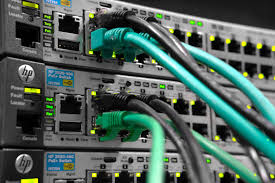
Network switches are the integral unit of a data center. A network switch is a device that connects multiple devices within a network. It enables them to connect by forwarding data packets. It optimizes network performance and facilitates efficient connectivity between servers, storage devices, and other network components. A right switch ensures uninterrupted data flow and exceptional performance.
Managed Switches: These are fully configurable switches that enable network administrators to monitor, configure, and prioritize traffic. They are best for advanced network setups, enterprises, and data centers.
Unmanaged Switches: They are plug-and-play switches with no configuration options. Ideal for home networks and small offices with basic connectivity requirements.
PoE Switches: They provide electrical power and network connection over a single Ethernet cable. Best for IP cameras, VoIP phones, and access points.
Smart/Hybrid Switches: They are a middle ground between unmanaged and fully managed network switches.
Layer 2 vs. Layer 3 Switches: Layer 2 switches operate at the data link layer and forward traffic based on MAC addresses. Layer 3 switches include routing capabilities (like a router) and operate on IP addresses. They work best for inter-VLAN routing and larger networks.
Modular vs. Fixed Configuration:
Modular switches come with a chassis and allow you to add or remove modules as needed, based on your network’s requirements. Best for core network layers that require flexibility and high availability.
Fixed configuration switches have a predefined number of ports and limited customization options.
Feature | Unmanaged | Smart | Managed |
Configuration | None | Basic (VLAN, quality of service) | Full (VLAN, quality of service, CLI, SNMP, ACLs) |
Management Access | None | Web Interface | CLI, Web, SNMP, SSH |
Layer Support | Layer 2 | Layer 2 (some L3) | Layer 2 & Layer 3 |
Use Case | Basic LAN | Small/Medium Office | Enterprise/Data Center |
Cost | $ | $$ | $$$ |
Compatibility:
Primarily, the compatibility of a network switch involves physical layer, protocol, and management compatibility.
Port Compatibility:
Cables and Connectors
Interface Types
Transmission Rate
Protocol Compatibility:
Ethernet
Other Protocols
Layer 3 Functionality
Management Compatibility:
VLANs
Link Aggregation (LAG)
Switch Clustering
Management Protocols
Device Compatibility:
Routers
PoE (Power over Ethernet)
Cisco, Juniper, Arista, HPE Aruba, NETGEAR, and TP-Link
NETGEAR GS108X
Tp-link Tl-sg105-m2
Cisco Catalyst 9500 Series
Ubiquiti UniFi USW-Flex
Juniper EX2300

Subscribe for deals, new products and promotions
